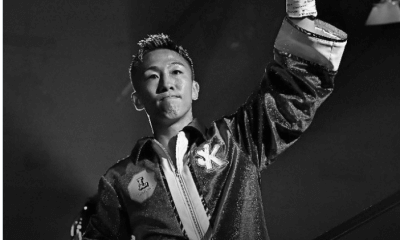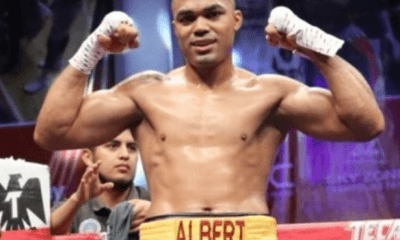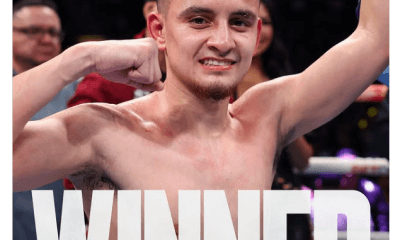Canada and USA
For Some Elite Boxers, `Prime Time’ Can Be Too Short a Time
When a world champion fighter is young, talented and at the top of his form, he can be excused for daring to believe the good times are going to last forever, or at least for a long time. But boxing is a “hurt business,” as the saying goes, and the glittering promise of all those tomorrows can be forever shrouded in darkness with one very bad night.
Potentially brilliant careers have been rapidly derailed inside the ropes, where longtime heavyweight champion Joe Louis once noted that even good fighters can run, but they can’t hide. For every marvel of longevity, an Archie Moore or George Foreman or Bernard Hopkins who perform at a high level beyond any reasonable expectation and don’t appear to have suffered irreparable damage, there are shooting stars who briefly light up the sky but prematurely fade to gray and then to black. Some continue to soldier on, even winning another world title in a couple of instances, but the line of demarcation between career ascent and descent often is starkly drawn.
Five potential Hall of Famers who fell short of the indisputable greatness once predicted of them serve as cautionary tales of what can happen whenever a fighter enters the ring as something special and exits as something far less, his prime literally having been beaten out of him.
David Reid, Meldrick Taylor, Donald Curry, Michael Nunn and Chad Dawson deserve to be remembered for what they were, which was better than most fighters ever get to be, but also for what they might have been had they not slammed head-first into an opponent, and circumstances, capable of turning their fondest dreams into lingering nightmares.
Felix Trinidad UD12 David Reid, March 3, 2000, Caesars Palace, Las Vegas
He might have become the next Oscar De La Hoya. Just as De La Hoya, the “Golden Boy,” became an instant celebrity when he won the United States’ only gold medal in boxing at the 1992 Barcelona Olympics, Philadelphia’s David Reid appeared to have positioned himself to cash in on his moment of glory at the 1996 Atlanta Olympics. Just three months after he was working as a stock-room clerk at JC Penney, Reid, trailing on the scorecards, delivered a crushing overhand right in the final round to knock out favored Cuban Alfredo Duvergel in the 156-pound Olympic final.
Several major promotional companies sought to sign Reid, who at first seemed on the verge of joining De La Hoya as part of Top Rank founder Bob Arum’s deep Top Rank stable. “David Reid is a national hero. He is the man of the moment,” Arum said in New York, where Reid and De La Hoya posed together for photographers.
“David Reid and I will fight someday,” De La Hoya predicted. “The only gold medalist from ’92 vs. the only gold medalist from ’96. Man, wouldn’t that be something? It won’t happen soon, but it will happen.”
Shortly thereafter, however, Reid accepted a bigger-bucks offer from a start-up promotional outfit, America Presents, which assured him he would be the face of the company and not a set-up man for De La Hoya or any of the other more-established Top Rank headliners.
Reid never did get around to fighting De La Hoya, but he was put on an accelerated schedule while under the aegis of America Presents, fighting for and winning the WBA super welterweight championship in just his 12th pro bout, a 12-round unanimous decision over France’s Laurent Boudouani on March 6, 1999. Reid made two successful defenses of that title, on points over Kevin Kelly and Keith Mullings, but concerns grew over a droopy left eyelid which two surgeries had failed to correct. There was a certain amount of skepticism from the boxing cognoscenti when Reid stepped way up in class for his third defense, against Felix Trinidad, the WBC and IBF welterweight champion. Although both men were 27 years old, Trinidad (then 36-0 with 29 KOs) was by far the more experienced fighter, and would be appearing in his 17th world title bout.
The skepticism proved to be justified. Although Reid landed the same overhand right that had put Duvergel down and out in the Olympics, flooring Trinidad in the third round, the favored (by 3-to-1) Puerto Rican superstar beat the count and in the seventh round he dropped Reid with a left hook. It was all Tito the rest of the way, never more so than in the 11th round when he scored three more knockdowns, although referee Mitch Halpern declined to step in and halt what had become a brutally one-sided fight.
“As a man, as a fighter, the referee saw I could continue,” said Reid, whose grotesquely swollen right eye nearly matched his left eye that was constantly at half-mast. “I wasn’t going to quit. Tito was the better man tonight. But, again, I wasn’t going to quit.”
There are those who believe Reid was rushed into the big-money fight with Trinidad while he was still marketable, which is to say before the droopy eyelid problem reached critical mass. In any case, Reid fought only four more times after that beatdown, losing twice, including a ninth-round stoppage at the hands of journeyman Sam Hill on Nov. 11, 2011, in the well-known boxing hotbed of Elizabeth, Ind. America Presents ceased operation and Reid never came close to receiving all of the financial guarantees he had been promised at the outset.
“Earlier, I got by OK,” he said of the droopy eyelid that might have damaged his bid for lasting glory as much as Trinidad’s fists had. “But in that last fight, it was like I saw those right hands, but I couldn’t get out of the way of them. That’s when I knew it was time to get out.”
Julio Cesar Chavez TKO12 Meldrick Taylor, March 17, 1990, Las Vegas Hilton
It might have been the finest boxing match of the 1990s, both in terms of the quality of the principals and the nearly nonstop action they delivered in the ring. But what it also was, without question, was the most controversial fight of the decade.
The super lightweight unification showdown between two undefeated champions, the WBC’s Julio Cesar Chavez (then 68-0, with 49 KOs) and IBF’s Meldrick Taylor (24-0-1, 13 KOs), was the kind of bout that the fight game cries out for, but too seldom gets – and when one does come around, it sometimes doesn’t deliver. Chavez was only 27 at the time, a devastating body puncher who could turn ribcages into kindling, and Taylor, a gold medalist at 17 at the 1984 Los Angeles Olympics, was a 23-year-old with the fastest hands in the sport. It was a classic pairing of power vs. speed, of Mexican grittiness against Philly heart.
For much of the way, Taylor’s rapid-fire combinations were stealing the show, piling up points and edging “JC Superstar” ever closer to what appeared to be his first defeat. But Chavez was doing even more damage in the many toe-to-toe exchanges, his heavy hands inflicting cuts inside Taylor’s mouth that led him to ingest a pint of his own blood, and also breaking bones around his left eye. But instead of sticking and moving in the later rounds, the better to sit on his presumed lead, Taylor continued to meet fire with fire. It was, after all, the Philadelphia way.
Far enough ahead on two scorecards that he couldn’t lose on points, a bruised and battered Taylor again went right at Chavez in the 12th round, but he was knocked down in the closing seconds. He managed to beat the count, but was looking at his corner, where co-trainer Lou Duva was frantically trying to get his attention, instead of referee Richard Steele. Steele then waved his arms and awarded Chavez a TKO victory two seconds before the final bell.
The heartbreaking finish wasn’t really the end of Taylor’s career; two bouts later he wrested the WBA welterweight title from Aaron Davis on a unanimous decision and defended it twice. But it was increasingly apparent this was not the pre-Chavez Meldrick Taylor, and he took a thumping in a failed bid to win Terry Norris’s 154-pound strap, suffering a fourth-round stoppage. Taylor was merely a ghost of his standout former self in the fight after that, losing his WBA welterweight title on an eighth round TKO to Crisanto Espana in London. Only 12 days past his 26th birthday, Taylor was urged to retire by Duva and his other trainer, George Benton.
“I don’t think it’s ever one fight that does it, but I don’t think Meldrick was ever really the same after he fought Chavez,” Duva said.
Taylor didn’t quit. He got his rematch with Chavez and again was stopped, in eight rounds, on Sept. 17, 1994. From there, things only got worse. Accepting short-money bouts wherever he could get them, he fought at the Blue Horizon and lost to a club fighter named Darren Maciunski. Taking note of his slurred speech, several state boxing commissions declined to grant him a license.
Lloyd Honeyghan RTD6 Donald Curry, Sept. 27, 1986, Caesars Atlantic City
They called him “The Lone Star Cobra,” and the nickname fit. Donald Curry, a native of Fort Worth, Texas, seemingly had everything going for him: a big punch, excellent mobility, solid boxing skills and, oh, yeah, the WBC, WBA and IBF welterweight championships. He was 25-0 with 19 knockouts heading into what appeared to be, on paper, an eminently winnable defense against Lloyd Honeyghan. Although the Jamaican-born Briton came in 27-0 with 16 knockouts and was the WBC’s No. 1-rated contender, few gave him much of a chance of knocking off Curry, who was close to attaining superstar status, if he hadn’t already risen to that level. Curry was such a prohibitive favorite that few of the legal sports books were accepting bets on the fight. The prevailing wisdom at the time was that the electrifying, 25-year-old Curry would soon move up to middleweight to challenge Marvin Hagler.
But Honeyghan apparently hadn’t read Curry’s press clippings, or if he had, he wasn’t impressed by them. He took the fight to Curry from the get-go and made it at close quarters, disrupting Curry’s rhythm and scoring with big shots of his own. As a horrified Bob Arum – who had envisioned making a superfight between Curry and Hagler at 160 pounds – looked on from ringside, Honeyghan so battered the venomless Cobra that referee Octavio Meyran, on the advice of ring physicians Frank B. Doggett and Paul Williams, stopped the one-sided bout at the end of six rounds. It was a call that Curry – who had struggled to make weight, only doing so by paring 11½ three days before the fight — did not object to; he had a three-inch cut over his left eye and had been staggered more than once.
Curry remains on the IBHOF ballot, as does Meldrick Taylor, but his prime might have been too compressed to receive the widespread support necessary for induction. He was 9-5 after his comeuppance from Honeyghan, four of the five defeats coming inside the distance, to finish 34-6 with 25 KOs.
James Toney TKO11 Michael Nunn, March 10, 1991, Davenport, Iowa
It might seem strange now, given the career and life turns taken by each man. James “Lights Out” Toney is almost certainly a first-ballot inductee into the IBHOF, having won three world championships in three weight classes during a 27-year pro career that might or might not have ended in 2015. For all anyone knows, he might yet decide to lace up the gloves again, at 48. Michael Nunn, on the other hand, was sentenced to 24 years in prison in 2004 for drug trafficking. He has not thrown a punch for pay since 2002 and, if anything, he is remembered more for having squandered his opportunity to achieve some of the many plaudits that since have passed to Toney.
On March 10, 1991, Nunn, a slick southpaw with silky moves, was the more highly regarded fighter. In fact, he was much more highly regarded. Heading into the sixth defense of his IBF middleweight title against Toney, in Nunn’s hometown of Davenport, Nunn was considered a top five pound-for-pound fighter by nearly every media outlet. Toney, despite his 25-0-1 record with 18 KOs, was a 20-1 underdog in some sports books.
As a raucous, pro-Nunn crowd in John O’Donnell Stadium roared its approval, the hometown hero appeared on his way to a nod on points. The champion was quicker, his jab accurate and he landed right hooks in the fifth and sixth rounds that briefly wobbled Toney. Heading into the late rounds, the smart move would have been for Nunn to continue sticking and moving, but he might have used up too much energy going for the knockout. Toney dropped him in round 11 with a ripping left hook, and although Nunn made it to his feet at the count of nine, he was hurt and gassed. Surging forward, Toney landed two jolting right hands and Nunn’s cornermen entered the ring, ending the fight after an elapsed time of 2 minutes, 14 seconds.
The stunning defeat was a cold slap in the face to Nunn, who had carried himself with the air of someone who thought he was invincible. He captured the WBA super middleweight title two fights later, beating Victor Cordoba, but it was a split decision in which Nunn flashed little of his former brilliance. Reminders of who and what he had been at his peak became more sporadic and, on Feb. 26, 1994, Nunn was dethroned in London by someone who really should have been a 20-1 underdog, Steve Little, who was 21-13-2 with five KO wins.
Andre Ward TKO 10 Chad Dawson, Sept. 8, 2012, Oracle Arena, Oakland, Calif.
When last we saw “Bad” Chad Dawson in the ring, he was stopped in the 10th and final round of his bout with Andrzej Fonfara on March 4. It was the two-time former light heavyweight champion’s third defeat in his six most recent bouts, two inside the distance, signaling the likelihood that, Dawson, at 34, might never regain the form that four years earlier had made him a consensus top10 pound-for-pound fighter.
A rangy southpaw, Dawson had begun his career by going 29-0 with 17 KOs. He suffered his first loss on Aug. 14, 2010, and the transfer of his WBC and IBO 175-pound titles, on an 11-round technical decision against Jean Pascal in Pascal’s hometown of Quebec City, Canada. But Dawson – whose resume to that point included victories over such quality opponents as Tomasz Adamek, Antonio Tarver (twice) and Glen Johnson — rebounded nicely, winning decisions over Adrian Diancou and Bernard Hopkins, the latter for Hopkins’ WBC light heavy belt that the ageless wonder from Philly had lifted from Pascal. Dawson might have made it two straight over Hopkins, but their first match, which initially was ruled a second-round TKO for the challenger, was changed to a no-decision because of the accidental injury (a dislocated shoulder) suffered by B-Hop when he was picked up and thrown to the canvas when the two fighters became entangled in a clinch.
Dawson then opted, perhaps unwisely, to trim down to super middleweight for a high-visibility shot at WBC/WBA 168-pound ruler Andre Ward. Demonstrating that he was indeed still at the top of his game, and that Dawson apparently wasn’t, Ward registered knockdowns in the third, fourth and 10th round. A badly beaten Dawson, when asked if he was able to continue after the last knockdown, told referee Steve Smoger he was able to continue, but his response was less than enthusiastic. Asked again if he wanted to go on, Dawson said, “I’m done.”
That answer might have been more comprehensive than anyone could have imagined at the time.
Check out more boxing news on video at The Boxing Channel.
-

 Featured Articles3 weeks ago
Featured Articles3 weeks agoThe Hauser Report: Zayas-Garcia, Pacquiao, Usyk, and the NYSAC
-

 Featured Articles2 weeks ago
Featured Articles2 weeks agoOscar Duarte and Regis Prograis Prevail on an Action-Packed Fight Card in Chicago
-

 Featured Articles1 week ago
Featured Articles1 week agoThe Hauser Report: Cinematic and Literary Notes
-

 Book Review3 days ago
Book Review3 days agoMark Kriegel’s New Book About Mike Tyson is a Must-Read
-
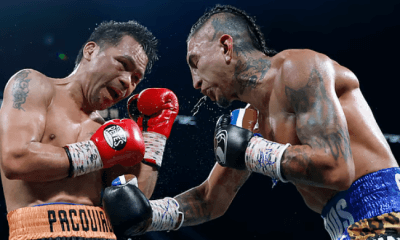
 Featured Articles4 weeks ago
Featured Articles4 weeks agoManny Pacquiao and Mario Barrios Fight to a Draw; Fundora stops Tim Tszyu
-
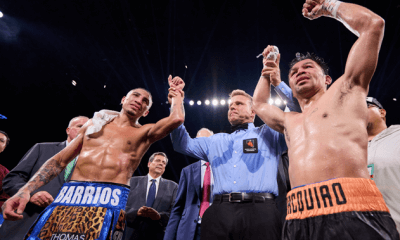
 Featured Articles3 weeks ago
Featured Articles3 weeks agoArne’s Almanac: Pacquiao-Barrios Redux
-

 Featured Articles2 weeks ago
Featured Articles2 weeks agoRemembering Dwight Muhammad Qawi (1953-2025) and his Triumphant Return to Prison
-
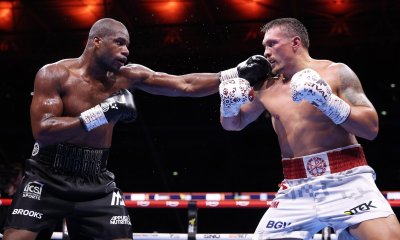
 Featured Articles4 weeks ago
Featured Articles4 weeks agoOleksandr Usyk Continues to Amaze; KOs Daniel Dubois in 5 One-Sided Rounds






